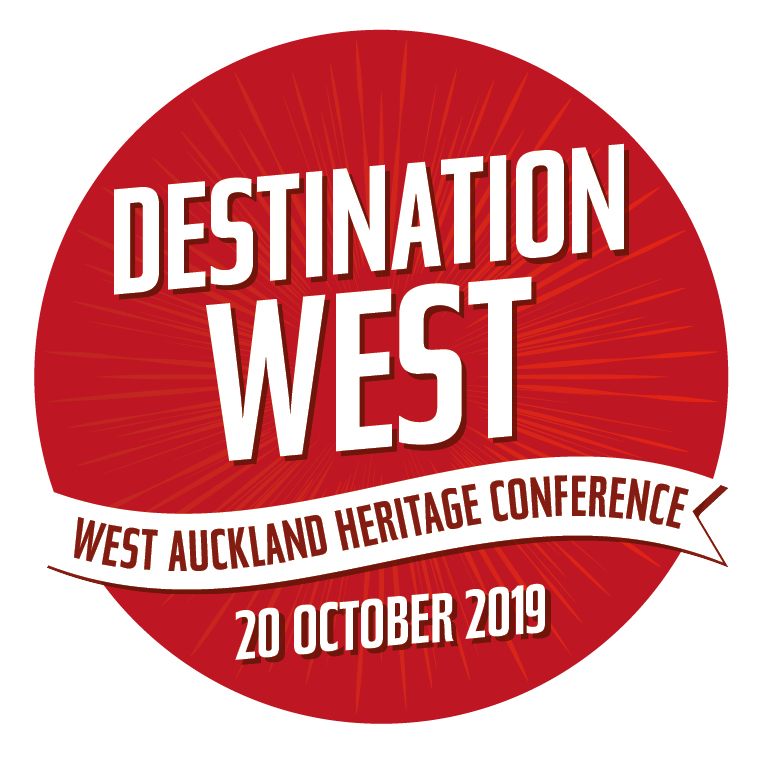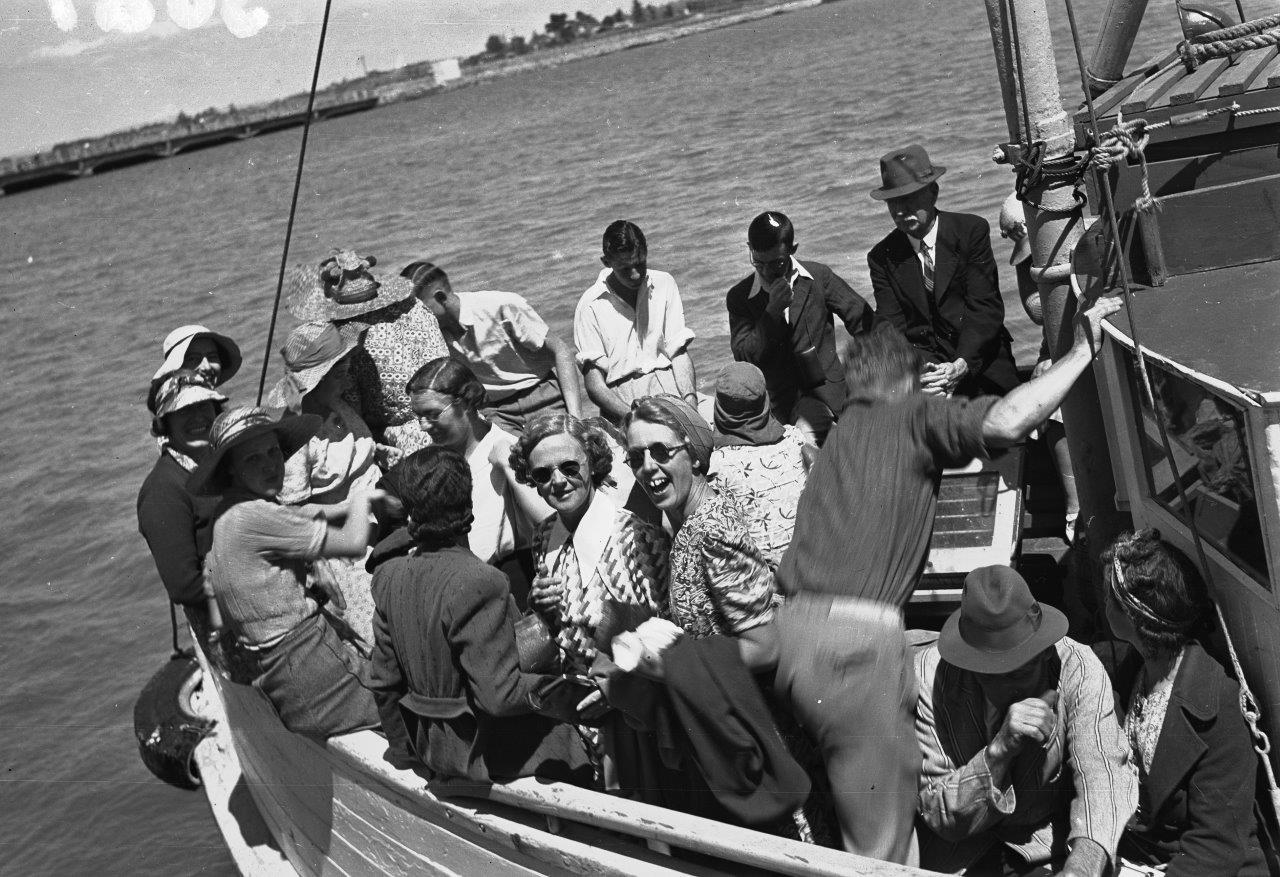
Welcome to Destination West
Sunday 20 October 2019
the fourth edition of the West Auckland Heritage Conference
2019 programme

Image: View of Auckland Tramping Club members on a launch off Onehunga, 1942. Photographer: Isabel Hooker. J. T. Diamond Collection, JTD-19k-03087
KEYNOTE SPEAKERS – Titirangi War Memorial Hall
Greame Murdoch
Graeme Murdoch’s presentation will discuss early Maori ancestral journeys undertaken in West Auckland by Kupe mai Tawhiti, Toi Te Huatahi and Rakataura of the Tainui waka, as remembered in local traditions and place names.
Robyn Mason -
Auckland’s oddest architectural relic stands in a grassy hollow beside Central Park Drive in Henderson. Marooned in a swathe of green, the partially buried Swan’s Arch keeps vigil to the secrets of its maker – Henry C. Swan ‘the hermit of Henderson Creek’ – the English solicitor-sailor who for 30 years lived nearby aboard his Charles Bailey yacht Awatea at the beginning of the 20th century. He was inspiration to a local girl who became a world recognised scientist, provided the basis for one of Maurice Shadbolt’s finest novels, and his mysterious life generated an urban legend. Local historian Robyn Mason sorts fact from fantasy in the story of Mr Swan.
Isaac McIvor and Larry Paul
Isaac McIvor is conditionally enrolled as a doctoral student at the University of Waikato. He recently left his position as Archaeologist at Heritage New Zealand Pouhere Taonga. In this position, Isaac, played a leading role in managing the archaeological site of the wrecked 1863, New Zealand built, schooner named Daring, at Te Oneone Rangatira (Northern Muriwai), South Head. Isaac will present on the collaborative project that had the purpose of preserving this nationally significant piece of New Zealand maritime heritage, including its identification, recording, excavation and relocation. Larry is the project coordinator and social media member of the Daring Rescue Group as well as the skipper of the classic yacht Waitangi, having sailed on her since she returned to New Zealand from Melbourne in 2003.
AFTERNOON SESSIONS – at three locations
Location:
Titirangi Community House
Location:
Titirangi Library
Location:
Te Uru
Sandra Coney
Sandra Coney – Who were Piha’s kauri bushmen?
From 1910 to 1921 a 100-strong team of bushmen cut out Piha’s remote kauri forest which had been protected from the sawmillers by the wild coast and rugged terrain. For two decades Sandra Coney has been researching who the men were, where they came from, and what happened to them after they enlisted for WW1, and will share her sometimes surprising results. She will paint a picture of the Piha village as it existed in the years before the subdividers and holiday-makers came along to once again change the landscape from forest to bach community.
Location: Titirangi Community House
John Walsh
Hotel Titirangi – now called Lopdell House – was one of the most glamorous New Zealand architectural projects of the inter-war years. A bit too ambitious, as it turned out – the hotel opened just as the Depression deepened – but its enduring quality is evident in its restored state. The building’s architect also has a compelling story. William Bloomfield was probably the first registered architect of Māori descent. He studied in the United States, worked in the UK, was a fighter pilot on the Western Front in the First World War, had a taste for business adventures, and designed Auckland landmarks such as the Station Hotel, General Buildings and Queens Arcade. As an architect, he was fluent, versatile and, as Lopdell House demonstrates, very talented.
Location: Titirangi Library
Andrew Clifford
Spend some quality time with one of Colin McCahon’s biggest works on its last day at Te Uru as part of the McCahon centenary exhibition, ‘A way through’ Colin McCahon’s Gate III. Te Uru Director, Andrew Clifford, will introduce this unique exhibition, based entirely on a single painting, and will discuss the history and significance of this major work, which has not been seen in Auckland since it was first shown in 1971, and is currently on loan from the Victoria University of Wellington Art Collection. McCahon and his family were based in Titirangi in the 1950s, and he went onto establish a studio in Muriwai, where he continued to paint large-scale works inspired by the raw landscape of the west coast.
Location: Te Uru
Lisa Truttman
Some journeys into the wild bushlands of the Waitakere Ranges in the 19th century ended in heartbreaking tragedy. Such was the case for the young Presbyterian Reverend David Hamilton, when a July ride from Avondale in 1873 to the timber milling settlements in the ranges and along the Manukau coast, along with his lack of “bush sense,” eventually brought his untimely end. Local historian Lisa Truttman relates his last journey to the final resting place in a small churchyard in the Whau.
Location: Titirangi Community House
Meredith Youngson
The Swanson Railway Station Project began at the end of 1993 when a group of Swanson residents got together to save the historic Avondale Railway Station which was to be demolished. The process of acquiring the Station and the railway land in Swanson, then moving the station to the site took nearly two years of dedicated effort. The restoration of the station and formation of Swanson Station Park took a further five years. I will talk about the challenges and the triumphs of being involved in this project, and what it has meant to the Swanson Community then and now.
Location: Titirangi Library
Finn McCahon-Jones
Location: Te Uru
Peter Beveridge
At his retirement as Chief Ranger Bill Beveridge had worked in the Waitakere Ranges for 34 years. Bill has been part of this landscape his whole life, born in Parau 1925. He established the Arataki Visitor Centre, rangers house, toilets, depot and nursery as well as the Nature Trail. He trained many cadets fresh out of high school, teaching skills as well as sharing values of hard work in all weathers. His son Peter Beveridge grew up here as well and will share anecdotes of the life of the man known as “Mr Waitakere”.
Location: Titirangi Community House
Barbara Harvey and Gayle Marshall
Our book Whispers the Wind tells just a few of the many stories that lie buried in Waikumete Cemetery. It is the culmination of many hours of research by Lisa Truttman on behalf of “Friends of Waikumete”. Waikumete is not just a park/burial place. It is a repository for so much history, tales of tragedy, heroism, as well as dastardly deeds…it encapsulates society of the time 1881 – 1918. Our book is intended as a guide to walking in the cemetery, to find the graves that feature in the book and to learn more about this often overlooked jewel in our midst. Our presentation will include snippets from some of the stories in the book.
Location: Titirangi Library
John Edgar
Renowned sculptor John Edgar will be discussing his 2009 project “Ballast”, which was inspired by the story of emigrants leaving their homeland, the voyage through unknown seas and the arrival in a new land. John connected with his Scottish roots during a visit in 2005. He collected stone from historic quarries in Scotland, and created these sculptures which echo the land, the Saltire and the compass. Stone was traditionally used as ballast on boats, keeping them stable on a journey. Like the emigrants on board these boats, the stones left Scotland for New Zealand. Here they were altered, both physically and culturally, and returned to Edinburgh for exhibition at the National Museum of Scotland in 2009. The stones have now returned to New Zealand, completing the cycle.
Location: Te Uru
END EVENT – at Titirangi War Memorial Hall
Sam Sampson
Fifty years ago Colin McCahon painted onto the front of Maurice Shadbolt’s studio bar – As there is a constant flow of light we are born into a pure land. This may not have been McCahon’s most seminal work, or even in the pantheon of great McCahon paintings, but its utilitarian value and sheer chutzpah (painted spontaneously onto a studio bar) is quite remarkable.
Sam Sampson was born in the same year this work was painted, and grew up, and still lives in his childhood home, not far from the Shadbolt house. In a series of new poems, and in a poetic exchange with C.K. Stead, he responds to McCahon’s text while highlighting the importance of his local environment.
Location: Titirangi War Memorial Hall

